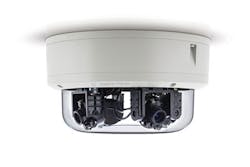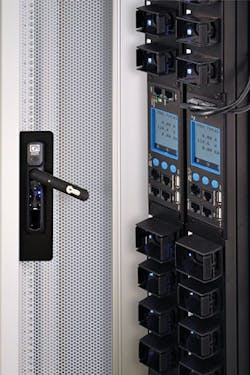Editor's Picks
CommScope, Kathrein sign IP cross-license agreement for base station antennas, DAS, filters
CommScope and Kathrein have entered into a long-term global agreement to cross-license portions of their patent portfolios, increasing each company’s ability to develop new solutions, serve customers and compete in the global market, the companies said when announcing the agreement.
The cross-license agreement relates to passive base station antennas, distributed antenna systems (DAS) and filters. Under the agreement, each company can access and implement the other company’s patents and technologies globally.
“This is a win-win for both parties, demonstrating our mutual commitment to innovation and wireless industry development,” said Ben Cardwell (pictured left), senior vice president, CommScope mobility solutions. “CommScope engineers will enjoy greater freedom of design, accelerating our research and development in antennas and filters, while Kathrein gains access to our valuable digital DAS patents.”
Kathrein is the first and only company that CommScope has licensed to its digital DAS patent portfolio. As part of the agreement, Kathrein agreed to an undisclosed upfront payment and ongoing royalties specific to the digital DAS portfolio. CommScope gains access to Kathrein’s passive base station antenna and filter portfolios. Further details of the agreement were not disclosed.
“We are pleased with the global cross license agreement with CommScope,” said Jürgen Walter (pictured right), executive vice president, solutions division, Kathrein. “This agreement reflects the two leading companies’ joint view that innovation sharing and standardization of technology is critical to driving and accelerating industry evolution as we head into 5G customer requirements and future deployments.”
CommScope and Kathrein note each has invested substantial resources in bringing their wireless solutions to market and have built substantial patent portfolios to protect their respective investments. Both companies emphasize that they are committed to protecting their intellectual property rights.
MACOM unveils PAM-4 technology chipset for single-lambda 100G, 200G and 400G data center optical connectivity
At the Optical Fiber Communication Conference and Exposition (OFC 2017) in March, MACOM Technology Solutions unveiled a complete PAM-4 technology chipset for 100G data rates over a single wavelength, enabling single fiber and four-lane parallel fiber connectivity for 100G, 200G and 400G Ethernet applications.
The company contends that “increased traffic within and between cloud data centers is driving the need for low-cost 100G, and for high-speed and low-power 200G and 400G interconnects. To increase bandwidth density per port, data center OEMs are adopting faster data rates starting in 2018. These interconnects will be supported with smaller QSFP, QSFP-DD and OSFP form factor modules, which require suppliers to deliver lower power electronic components.”
MACOM says its new chipset “addresses these power and bandwidth density needs by supporting single wavelength interconnects with EML lasers or silicon photonics, within the power envelope requirements of these smaller form factor modules.”
“The major data center operators are currently deploying 100G optics in volume to build their intra data center switching fabrics,” points out Ian Redpath, practice leader, components, transport and routing, at the technology analyst firm Ovum. He adds, “Today, the data center intra-connect market is driven by the advances in Ethernet switch ASICs. As 400G switches enter the market, optical transceivers will need to keep pace and rapidly transition to 400G. Ovum projects the 100G equivalent data center intra-connect market to grow at an explosive 56-percent CAGR by 2021, driving the need for low cost 100G over single lambda solutions. At the same time the industry will start adoption of higher-speed 400G links also utilizing single lambda technology. We expect MACOM’s PAM-4, TIA, CDR and laser driver chipset will help drive these deployments.”
MACOM says the new chipset features a new transimpedance amplifier (TIA), as well as transmit and receive clock and data recovery (CDR) devices, and a linear electro-absorption modulated laser (EML) driver module.
Allied Wire and Cable distributing Prysmian/Draka industrial fiber-optic cable
Allied Wire and Cable is now a distributor of Prysmian Group/Draka industrial and harsh-environment fiber-optic cables.
When announcing the addition to its offerings, Allied said, “As a distributor of Prysmian’s low- and medium-voltage cable products, this announcement expands the product set and adds to our $50 million inventory. This expansion will allow Allied to now serve a customer base within the fiber-optic and harsh-environment industry.”
Allied Wire and Cable’s president, Tim Flynn, commented, “We are pleased to join with Prysmian to serve the growing needs for fiber cable used in industrial and harsh environments. Our touch points in the industrial market are a perfect match with Prysmian’s industry-leading product portfolio of fiber cables and adds to the portfolio of low-voltage and medium-voltage products that we distribute for Prysmian today.”
The distributor pointed out that in addition to the new customer base, it will be able to offer low prices on the industrial/harsh-environment fiber-optic cable product line as an exclusive distributor. “With the long list of equals, this will allow Allied customers to save money on name brands,” Allied concluded.
Omnidirectional megapixel camera features no-touch remote setup for rapid installation
Arecont Vision, an expert in in IP-based megapixel camera technology, has expanded its multi-sensor, multi-megapixel SurroundVideo omnidirectional camera series. The SurroundVideo Omni G3 is billed as the industry’s first camera in the multi-sensor product category - which the company says it pioneered in 2006 - that now offers no-touch, remote setup.
According to the company, a single high-definition SurroundVideo camera can replace multiple pan-tilt-zoom cameras or a large number of single-sensor cameras for a wide range of surveillance requirements.
As recapped by a company press release, “SurroundVideo has been proven in thousands of customer projects around the world, integrated with the customer’s choice of leading video management systems (VMS) and network video recorders (NVR). The first SurroundVideo Omni camera was introduced in 2014, bringing omnidirectional coverage in place of a fixed 180- or 360-degree view. The Omni G1 series was the first to offer four sensors that can be positioned independently around a patented, 70+ placement-point magnetic track to cover virtually any angle or view. SurroundVideo Omni G2 followed in 2016 to offer additional ease of movement and faster setup with motorized, remote focus three-axis gimbals.”
The new SurroundVideo Omni G3 “goes the final step,” adds Arecont Vision, by delivering no-touch remote setup. According to the company, the Omni G3 can be quickly installed on a wall, corner, ceiling, pole, emergency call box, or other structure. The camera is then connected to a single PoE (Power over Ethernet) IP network cable. The installer can then dismount from the ladder or lift, and connect to the camera’s integrated webpage over the network for setup. 180-, 270-, or 360-degree preset views can be selected, or the installer can adjust and position each of the sensors remotely, including remote focus, zoom, and tilt.
New presets can also be saved, so that the view can be completely changed when needed. For example, a stadium may have different viewing requirements for a sporting event versus a concert. The user can select the appropriate preset, and the camera will move the sensors to that new perspective. The camera can then be returned to the original view just as easily.
Intel appoints new chief strategy officer
On March 29, Intel Corporation announced the appointment of Aicha S. Evans as the company’s chief strategy officer. According to a press release, Evans “will be responsible for driving Intel’s long-term strategy to transform from a PC-centric company to a data-centric company, as well as leading rapid decision making and company-wide execution of the strategy.”
“Aicha is an industry visionary who will help our senior management team and the board of directors focus on what’s next for Intel,” Intel CEO Brian Krzanich commented. “Her new role reflects her strong strategic leadership across Intel’s business, most importantly in 5G and other communications technology. Her invaluable expertise will contribute to the company’s long-term strategy and product portfolio.”
Evans is an Intel senior vice president and has been responsible for wireless communications for the past nine years. Most recently, she was the general manager of Intel’s communication and devices group. “I look forward to working across the company to advance Intel’s ongoing transformation,” Evans said. “We have an exciting future ahead us.”
Evans joined Intel in 2006 and is based in Santa Clara, CA. In her new role, she will report to Intel’s CFO Bob Swan. An internal and external search is underway for a new general manager of Intel’s communication and devices group.
4G home/office cellular signal booster kit gets upgrade
weBoost recently rolled out its eqo 4G booster kit for providing up to 32x stronger signaling in the home, apartment or office, the company said. It added the easy-to-install eqo 4G device delivers up to 3.3x stronger signal and 1.7x greater coverage than its predecessor, the original eqo booster.
The eqo 4G can support multiple users and multiple devices on all carriers simultaneously in an open area of up to 1,500 square feet. The unit’s outside antenna receives 4G LTE and 3G voice and data signals and delivers them to the booster. The booster amplifies the signals and serves as a relay between the phone and the nearest cell tower. The device then receives a stronger signal, and calls and data are fed through the booster back to the network.
The kit comes with all parts needed for convenient installation, adds weBoost. This includes: one eqo 4G booster; one eqo 4G inside antenna; one eqo 4G outside antenna with integrated flat cable; one 6-foot cable; one 25-foot cable, and an AC power supply.
According to the company, “the eqo 4G brings accelerated 3G and 4G LTE signals into a home or office with up to 70-decibel system gain, meaning the booster brings up to a maximum of 32x the signal strength of the original inside signal. Whether someone is video-calling family across the country or finalizing a business plan over a teleconference, users can stop worrying about dropped calls and signal-compromised data streams. With the booster’s discrete, sleek and modern design, the setup will fit nicely in any room.”
Further, weBoost notes that “the eqo 4G plug-and-play system allows users to begin boosting indoor signal coverage after a quick, five-minute installation process. As part of this process, eqo 4G includes an easy-to-use high performance antenna in a small form factor, so it won’t take up much space.”
UL launches cable certification program for Power over HDBaseT cables
The HDBaseT Alliance and Underwriters Laboratories (UL) jointly announced the Certification Program for Power over HDBaseT (PoH) Cables.
In a statement, the organizations said, “This program, targeted at cable manufacturers, addresses the increased performance and safety requirements related to heating due to current levels being carried under PoH of audiovisual installations. With increasingly complex installations and the proliferation of Power over HDBaseT equipment, AV vendors, manufacturers and professionals have indicated the need for standardization and consistency for high performance, regardless of the size of cable bundles. The new certification program evaluates the cable’s ability to carry DC [direct current] power of up to 100 watts over the four pairs of the cable and to maintain HDBaseT data transmission performance.”
The certification program is based on the soon-to-be-published standard UL 4299, Outline of Investigation for Power over HDBaseT (POH) Cables. The program will evaluate the cables in accordance with the specifications of UL 4299. “The cables will be covered under UL’s Follow-Up Services surveillance program that includes both regular inspections at cable manufacturing facilities as well as ongoing testing to determine continued compliance,” UL and the HDBaseT Alliance added.
Ariel Sobelman, the alliance’s president, observed, “Until now, the HDBaseT Allliance had a Cable Recommendation Program in which it only tested cables for HDBaseT transmission. The new cable certification program goes one step further, providing increased transparency to vendors and end users and identifying the best cables for complex installations.”
UL’s vice president and general manager/wire and cable division, L.F. Lai, added, “As HDBaseT became the standard for the transmission of high-throughput content, it was natural for UL to join the efforts to help address the safety and performance issues of powering over these cable installations. Through the cable certification program, both vendors and end users will benefit from knowing that these cables are not only suitable to transmit HDBaseT, but also do so according to highly respected industry standards.”
Kyocera launches low-cost IoT services in Japan, in partnership with Sigfox network
Japan’s Kyocera Corp. announced that its subsidiary, Kyocera Communication Systems Co., Ltd. (KCCS) has started providing Internet of Things (IoT) network services in Japan based on the Sigfox global IoT network. The service is now available in Tokyo, Kawasaki City, Yokohama City and Osaka City, to be further planned for Japan’s 36 major cities by early 2018 and nationwide by 2020 with an annual sales target of JPY10 billion by FY2021.
The IoT market continues to grow worldwide with the number of connected devices estimated to reach around 53 billion by 2020, according to figures by Japan’s Ministry of Internal Affairs and Communications. However, there continue to be barriers to mass adoption for use in locations with no electric power source, especially for applications such as sensors with extremely low data volumes. In order to address those issues, KCCS is deploying the Sigfox LPWA [low power wide area] network which the company says “brings a breakthrough IoT solution with the lowest costs and longest battery life - two barriers to entry for many companies in Japan seeking to leverage mass IoT.”
The service has already made an impact in Japan with a variety of applications deployed or currently being tested. For example, for a smart parking system with OPTEX Company Limited, coin-operated parking spaces in Tokyo use smart vehicle detection sensors connected by Sigfox. Each parking space has OPTEX’s vehicle detection sensor, “ViiK,” to directly notify the cloud server of its usage and vacancy. “Eliminating work associated with trenching and cabling underground, the parking management system can be installed with less cost and less time,” contends Kyocera.
Comcast Cable undergoes leadership transition
Comcast Corporation announced that Dave Watson became president and CEO of Comcast Cable, as Neil Smit moved into a new role as a vice chairman of Comcast Corporation, effective April 1. According to a company press release, “for the next few months, Smit will work closely with Watson to ensure a smooth leadership transition. Smit will then work part-time with Comcast leaders to develop future technology-oriented business opportunities.”
The release continues, “Smit [pictured above] has had a stellar career, including seven years as the head of Comcast Cable. Prior to joining Comcast, Smit spent decades in senior executive positions at Charter, AOL, and Nabisco. Before his career in corporate America, Smit was a Navy SEAL, serving as a member of SEAL Team Six.”
The company adds that “Watson [pictured below], who joined Comcast in 1991, has served as the chief operating officer of Comcast Cable since 2010 and has partnered with Smit in running the cable division since Smit’s arrival at the company. He has held many senior roles within Comcast, including leadership of the product, sales, marketing, and advertising functions. Throughout his career, Watson has led transitions including from analog to IPTV and from early entry into high-speed internet to delivering gigabit speeds. He has also played a key role in Comcast’s expansion into commercial business services.”
Vision Technologies installing passive optical LAN at Washington healthcare clinic
Network integrator Vision Technologies Inc. recently announced it has been awarded a contract to provide Columbia Basin Health Association (CBHA) with a passive optical network infrastructure to support their new clinic building in Othello, WA. “CBHA has a strong tradition of expanding access to healthcare services and providing comprehensive and high-quality services to the communities they serve,” Vision Technologies said when announcing the contract award.
Describing what the passive optical LAN/passive optical network will support, Vision Technologies explained, “CBHA relies on technology to enable care delivery via electronic medical records (EMR), electronic dental records (EDR), digital radiology for medical and dental, pharmacy management systems (PMS), pharmacy robotics and more. CBHA selects and leverages its technology purchases not only to enable care delivery but also to support business processes, to recruit and retain staff, to promote patient satisfaction, and to provide the business-intelligence measures needed for effective decision-making.
“The installation environment begins with the 78,000-square-foot clinic that is currently under construction,” Vision Technologies added. “Ultimately, it will extend to residential units, a wellness center, and two retail business sites, all to be located on a 20-acre campus in Othello, WA.”
In addition to the applications described earlier, the passive optical LAN system will support building automation, access control, security cameras, on-demand video education, satellite TV, VoIP phones, fax, and voice-quality WiFi. Vision is providing a Tellabs passive optical LAN solution supporting more than 1,300 ports throughout the new clinic. Vision also is providing the network management software application and training for CBHA staff. The system design, Vision explained, will enable future growth and flexibility for any Ethernet application.
CBHA’s director of clinical services Doug Thompson explained, “We were seeking a partnering relationship with a company capable of designing and implementing a high-speed, highly reliable GPON [Gigabit Passive Optical Network] in our newest clinic, currently under construction. Preference was given to companies that can also train CBHA’s technical staff on system operation to provide upper-tier support on an ongoing basis.”
Chatsworth Products unveils electronic access control for data center cabinet physical security
Chatsworth Products, Inc. (CPI) recently introduced its eConnect Electronic Access Control (EAC) system, a networked locking solution for data center cabinets that allows data center managers to keep a log entry of each cabinet access remotely, adding another layer of security to the cabinet.
The eConnect EAC fully integrates with CPI’s vertical eConnect power distribution unit (PDU) models that have proprietary auxiliary ports, removing the need to power and network the locks separately. This integrated solution combines rack-level power management, environmental monitoring and remote access control into a single, easy-to-use PDU-based system.
Secure Array IP Consolidation, an eConnect feature that allows up to 32 PDUs to be linked under one network connection, works with the integrated cabinet ecosystem using a single network connection and one interface to monitor all three elements, which greatly simplifies rack management, notes the company.
Additionally, the EAC system works with CPI’s Power IQ for eConnect and other third-party DCIM software to provide a single source for white space/rack-level monitoring and control, and to consolidate data into a single database for cross reporting.
Customers can order the eConnect PDUs and locks preinstalled in CPI’s GF-Series GlobalFrame or F-Series TeraFrame cabinets using the company’s online product configurator.








